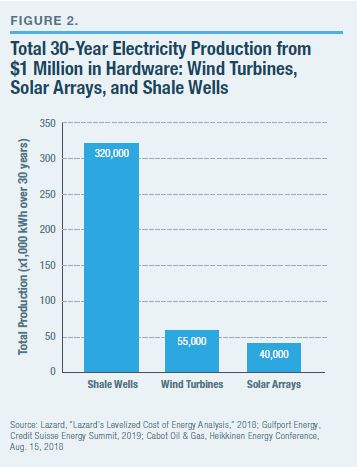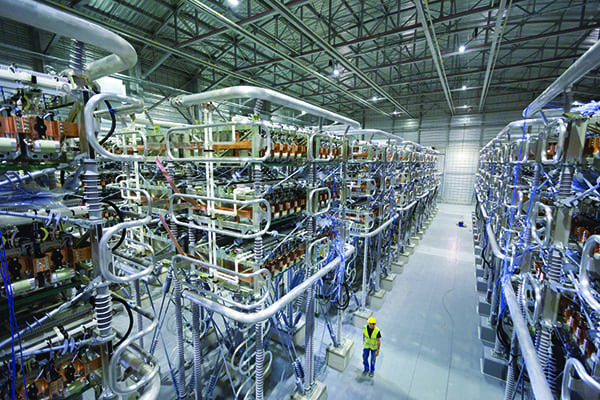excalibur
Diamond Member
- Mar 19, 2015
- 24,665
- 49,030
- 2,290
... how do we power the US when there is no sun available?
Unicorn farts.
Follow along with the video below to see how to install our site as a web app on your home screen.
Note: This feature may not be available in some browsers.
... how do we power the US when there is no sun available?


 www.manhattan-institute.org
www.manhattan-institute.org
That square is way too large. A 100 by 100 mile square would do. However, no one is going to do that, what will happen is that we will convert a lot of land to agrivoltaics, giving the farmer a second income, and conserving water in the process, as well as increasing his yield. And there will be in increasing adaptation of VPP's incorporating people roofs, mercantile and industrial parking lots, and mall and industrial roofs. The following article does not include the reduction of that area by the VPP's or agrivoltaics.Apparently at current technology, I will show you a picture of how many solar panels it would take to power the U.S. That is both day and night. (With the stored energy for nighttime) The square in yellow shows the total amount of area in solar panels it would take to do it. Argue with that you naysayers.
View attachment 538042
Man, are you ever going to get beyond the 1950's? Ever hear of pumped hydro? A half dozen designs to use gravity. And many others are using existing technology.How do you store the power that people need when the sun isn't available?
Batteries? That's a LOT of batteries, particularly when you consider we may soon be at war with the country that has most of the materials required to make them.
Additionally, our entire power grid works on AC. Batteries only store DC. You lose considerable power when you convert from one to the other, and then back again because most of our devices ultimately work on DC.
Damn fellow, can't you get anything right? The Hornsdale plant has a lot more storage than 70 MW/hrs.AC IS very efficient, for power transmission. Which is why our power grid generates AC, not DC
Much less so for running anything digital (which is basically everything we have now from computers to lightbulbs.
Converting from DC power generation to an AC grid is about 80% efficient. But, then you have to convert your AC from the wall to DC for your appliances, another 80% efficiency.
As for battery farms, the largest battery farm on the planet, built by Tesla Inc, in Hornsdale, Australia, has only enough capacity for 70 MW running for 10 minutes and 30 MW with a 3-hour capacity.
30 MW is only enough to power 3,000 homes or considerably fewer industrial sites.
The cost of converting our entire grid to a solar / windand building enough battery capacity to store that power (assuming there is enough Lithium on the planet to do so) would destroy our economy.
“One big advantage to HVDC is the efficiency of power transmission over long distances,” George Culbertson, vice president of power delivery markets for HDR, told POWER. “If the transmission line route is longer than about 300 miles, DC is a better option because AC lines have more line losses than DC for bulk power transfer.”AC IS very efficient, for power transmission. Which is why our power grid generates AC, not DC
Much less so for running anything digital (which is basically everything we have now from computers to lightbulbs.
Converting from DC power generation to an AC grid is about 80% efficient. But, then you have to convert your AC from the wall to DC for your appliances, another 80% efficiency.
As for battery farms, the largest battery farm on the planet, built by Tesla Inc, in Hornsdale, Australia, has only enough capacity for 70 MW running for 10 minutes and 30 MW with a 3-hour capacity.
30 MW is only enough to power 3,000 homes or considerably fewer industrial sites.
The cost of converting our entire grid to a solar / windand building enough battery capacity to store that power (assuming there is enough Lithium on the planet to do so) would destroy our economy.

 www.powermag.com
www.powermag.com

Apparently at current technology, I will show you a picture of how many solar panels it would take to power the U.S. That is both day and night. (With the stored energy for nighttime) The square in yellow shows the total amount of area in solar panels it would take to do it. Argue with that you naysayers.
View attachment 538042
LOL Says one of the most ignorant fellows on this board. Actually, it will take far less than that and, of course, will not be in one place. By the way, you have been predicting a cooling since you have been on this board. So, when is that cooling coming? All we have seen is increasing warming decade by decade. You have been 100% wrong 100% of the time.Try again. Good heavens you are ignorant.
Man, are you ever going to get beyond the 1950's? Ever hear of pumped hydro? A half dozen designs to use gravity. And many others are using existing technology.
You have virtually all of the Columbia basin with vertical elevations of up to 1000 ft. You build a large reservoir on top of the hill, and one at the bottom. You fill the top one once, and then only have to add for evaporation. you could easily put 20 of these on the Columbia in just Washington alone. Then there is the Snake. Hell's Canyon could host many more. There is practically the whole of the Pacific coast.The largest pumped storage facility in the world is Guangdong (Southern China). With a total capacity of 50 MILLION cubic meters of fresh water (in two vertically staged reservoirs), it has a total generating capacity of 2400 MegaWatts ... enough to power an industrialized city of 2 million people. Roughly 1/2 of a percent of the total US need (today).
To generate all US power of today (forget about the future) needs from pumped storage, would require a not only a fresh water storage 200 times that of the Chinese facility, 400 times more capacity than the environmentally disastrous 3 Gorges Dam (27 million cubic meters).
Where would you put a water catchment of that size, recognizing that there has to be several hundred feet of vertical distance between reservoir and the generating station?
What would be the consequences of a failure of recycling turbines that bring the used hydro from the generating stations back to the reservoir.
What would be the downstream consequences of a dam failure (a damn 400 times larger than any ever built before).
What would be the environmental impact of tying up 10 BILLION cubic meters of fresh water?

 nwlaborpress.org
nwlaborpress.org
In other words, no real answer to real solutions. Typical of dumb fuck "Conservatives". With our present technology with can easily go completely clean energy in a decade. And create a lot of wealth doing that. But people like you shit your pants over the thought of anything other than what you see right now. Such fearful little fellows.Environmentalism has produced more missionaries than any religion that ever came before it.
I'm considering that we deal with missionaries the old-fashioned way ...
View attachment 538118
The largest pumped storage facility in the world is Guangdong (Southern China). With a total capacity of 50 MILLION cubic meters of fresh water (in two vertically staged reservoirs), it has a total generating capacity of 2400 MegaWatts ... enough to power an industrialized city of 2 million people. Roughly 1/2 of a percent of the total US need (today).
To generate all US power of today (forget about the future) needs from pumped storage, would require a not only a fresh water storage 200 times that of the Chinese facility, 400 times more capacity than the environmentally disastrous 3 Gorges Dam (27 million cubic meters).
Where would you put a water catchment of that size, recognizing that there has to be several hundred feet of vertical distance between reservoir and the generating station?
What would be the consequences of a failure of recycling turbines that bring the used hydro from the generating stations back to the reservoir.
What would be the downstream consequences of a dam failure (a damn 400 times larger than any ever built before).
What would be the environmental impact of tying up 10 BILLION cubic meters of fresh water?
With our present technology with can easily go completely clean energy in a decade.
How much what.
Solar and wind are the least expensive forms of new generation now. They cost less than fossil fuel generation and far, far less than nuclear.
View attachment 538115


Damn fellow, can't you get anything right? The Hornsdale plant has a lot more storage than 70 MW/hrs.

 www.manhattan-institute.org
www.manhattan-institute.org
Gerard K. O'Neill wrote a book in 1977 titled "High Frontier", in it, he described how we could, with existing technology, build orbital cities with populations of tens or hundreds of thousands of persons, living in idyllic, organic, utopian splendor, all within a decade.
O'Neill even said the entire venture could be paid for by creating orbital solar power stations that would beam MegaWatts of free energy to earth in microwave beams.
To the layman (like myself) he made everything sound imminently achievable and I couldn't figure out why, as a nation, we weren't already gearing up to move America's best and brightest (among whom I envisioned myself) into the final frontier where we could all wear color coordinated velour jerseys and bang green alien chicks.
I was obsessed by that book and re-read it so many times that it fell apart. After my freshman year in college, I managed a summer job at JPL in Pasadena, near my campus. Everyone there, experts in the field of space and more obsessed with space than any people on Earth, had read the book and considered it optimistically hilarious.
O'Neill clearly overestimated the ability of rocket technology, and seriously underestimated the dangers the stations inhabitants would face from space-based radiation, not to mention the idea of aiming megawatts of microwave energy beams to the outskirts of major world cities. A global network of death stars.
The moral of this story is ... as any evangelist will tell you ... the utopian future you crave is right around the corner and there for the taking, just as long as you can convince the rest of those bonehead to send in their dollars.
How about this, Instead of destroying our economy, our environment, and our futures on HUGE, unsustainable mega-projects, hang on for a more viable technical solution like Fusion (fusion power is just 30 years away, and will always be so). Even the littlest of chickens give us a century or two before we are obliterated as a species. Personally, I'm hoping for at least a few decades of Mad Max apocalyptic fun land before we finally go out.
I do however, rest easy in the knowledge if someone ever does try to build one of these huge vanity projects, the environmental impact studies alone will doom it to development hell for decades.
We can't destroy the world.How much will it cost when we destroy the world with ...